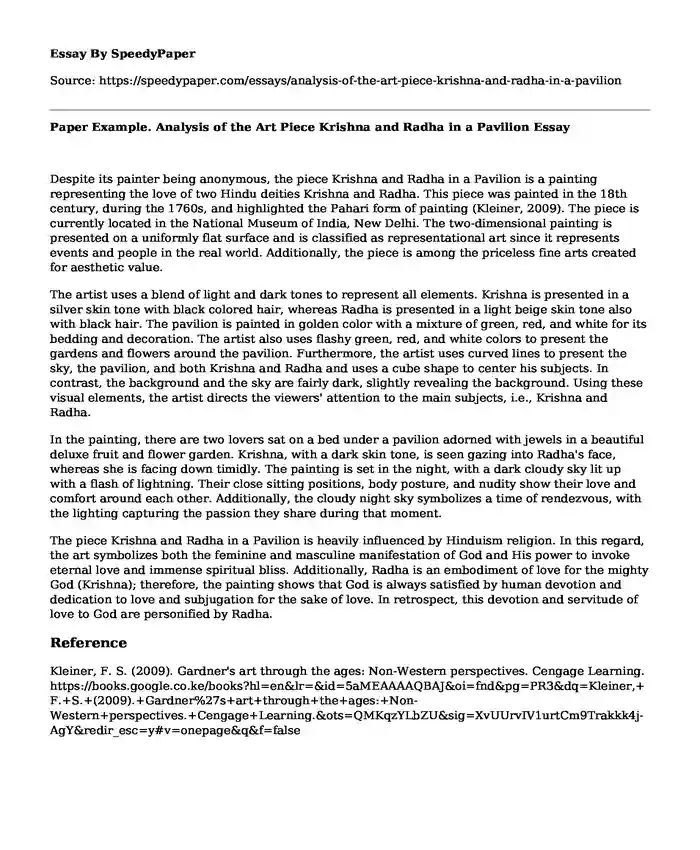
| Essay type: | Analytical essays |
| Categories: | Culture Arts Buddhism |
| Pages: | 2 |
| Wordcount: | 435 words |
Despite its painter being anonymous, the piece Krishna and Radha in a Pavilion is a painting representing the love of two Hindu deities Krishna and Radha. This piece was painted in the 18th century, during the 1760s, and highlighted the Pahari form of painting (Kleiner, 2009). The piece is currently located in the National Museum of India, New Delhi. The two-dimensional painting is presented on a uniformly flat surface and is classified as representational art since it represents events and people in the real world. Additionally, the piece is among the priceless fine arts created for aesthetic value.
The artist uses a blend of light and dark tones to represent all elements. Krishna is presented in a silver skin tone with black colored hair, whereas Radha is presented in a light beige skin tone also with black hair. The pavilion is painted in golden color with a mixture of green, red, and white for its bedding and decoration. The artist also uses flashy green, red, and white colors to present the gardens and flowers around the pavilion. Furthermore, the artist uses curved lines to present the sky, the pavilion, and both Krishna and Radha and uses a cube shape to center his subjects. In contrast, the background and the sky are fairly dark, slightly revealing the background. Using these visual elements, the artist directs the viewers' attention to the main subjects, i.e., Krishna and Radha.
In the painting, there are two lovers sat on a bed under a pavilion adorned with jewels in a beautiful deluxe fruit and flower garden. Krishna, with a dark skin tone, is seen gazing into Radha's face, whereas she is facing down timidly. The painting is set in the night, with a dark cloudy sky lit up with a flash of lightning. Their close sitting positions, body posture, and nudity show their love and comfort around each other. Additionally, the cloudy night sky symbolizes a time of rendezvous, with the lighting capturing the passion they share during that moment.
The piece Krishna and Radha in a Pavilion is heavily influenced by Hinduism religion. In this regard, the art symbolizes both the feminine and masculine manifestation of God and His power to invoke eternal love and immense spiritual bliss. Additionally, Radha is an embodiment of love for the mighty God (Krishna); therefore, the painting shows that God is always satisfied by human devotion and dedication to love and subjugation for the sake of love. In retrospect, this devotion and servitude of love to God are personified by Radha.
Reference
Kleiner, F. S. (2009). Gardner's art through the ages: Non-Western perspectives. Cengage Learning. https://books.google.co.ke/books?hl=en&lr=&id=5aMEAAAAQBAJ&oi=fnd&pg=PR3&dq=Kleiner,+F.+S.+(2009).+Gardner%27s+art+through+the+ages:+Non-Western+perspectives.+Cengage+Learning.&ots=QMKqzYLbZU&sig=XvUUrvIV1urtCm9Trakkk4j-AgY&redir_esc=y#v=onepage&q&f=false
Cite this page
Paper Example. Analysis of the Art Piece Krishna and Radha in a Pavilion. (2023, Oct 11). Retrieved from https://speedypaper.com/essays/analysis-of-the-art-piece-krishna-and-radha-in-a-pavilion
Request Removal
If you are the original author of this essay and no longer wish to have it published on the SpeedyPaper website, please click below to request its removal:
- Free Essays with Persuasive Speeches about Donating Blood
- Free Essay Sample on Product Design
- Free Essay: Impact of Musical Interventions on Language and Cognitive Development
- "Jazz with Bob Perkins," Jazz standards WRTI 90.1 FM. Free Essay
- Free Essay. Christian Perspective of the Nature of Spirituality and Ethics
- Essay Sample: The Jazz Concert Review of the Herbie Hancock 2008 Newport Jazz Festival
- Essay Sample on Maximus Masicus Visits the Orchestra
Popular categories




